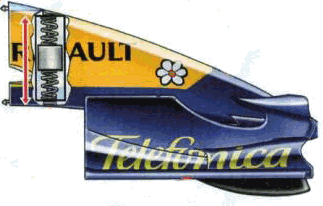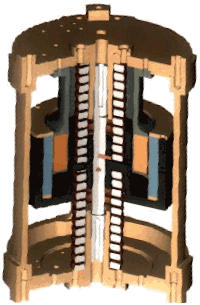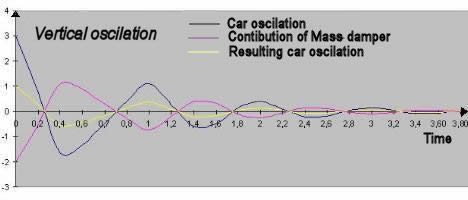Mass Damper
It's year 2006. During this year was a lot of controversies, and one witch created a most fuss was about Renault "Mass Damper".
What is Mass damper and how it work? What are advantages you get from it?
From Wikipedia:
"A tuned mass damper, also known as an active mass damper (AMD) or harmonic absorber, is a device mounted in structures to prevent discomfort, damage or outright structural failure by vibration. They are most frequently used in power transmission, automobiles, and in buildings.
Tuned mass dampers stabilize against violent motion caused by harmonic vibration. The presence of a tuned damper allows the inertia of a great mass to be balanced by a comparatively lightweight structural component, such as a heavy concrete block placed in such a way that the block moves in one direction as the building moves in the other, and damping the structure's oscillation. The counterweight may be mounted using massive spring coils and hydraulic dampers. If the axis of the vibration is fundamentally horizontal or torsional, leaf springs and pendulum-mounted weights are employed. Tuned mass dampers are engineered, or "tuned" to specifically counter harmful frequencies of oscillation or vibration."

In F1, this technology was first used by the Renault F1, French based squad in the 2005 Italian Grand Prix and has been raced relatively unnoticed, but suddenly, after the French Grand Prix 2006, the sports governing body decided it was illegal and ordered all teams which used it to remove it from their cars.
In 2006 Ferrari, Red Bull, Toro Rosso and Midland MF1 all followed the same path, and Honda and McLaren were still only testing it. Renault and Ferrari then transferred the principle to the rear of the car as well. At Hockenheim, Honda wanted to run a system with one mass damper in the nose and one other in the tank area, but 13 days prior to the race the FIA banned the concept with the argument that it is a moveable aerodynamic device. This action was a bit strange, because the FIA could have been aware of this argument already season before, and at the start of the season 2006, when they allowed various teams to use it.
So, how this stuff work in Renault F1car?
We must be clear about one thing first:
Renault mass damper is not a part of the cars suspension.

It was invented by Renault engineer Rob Marshall and consists of a mass, usually around 9kg in weight which is suspended between two springs. It sits inside the nose of the car, out of plain sight.
A suspension damper acts together with a springing system to influence the vertical movement of an unsprung mass - the respective wheel and tire assembly and its attendant linkages. In turn the combined motion of the four unsprung masses influences the movement of the sprung mass (car bodywork). In fact in the case of a Formula One car, we should say 'semi-sprung' rather than 'unsprung' because each tire acts as a spring in its own. The Formula One car is very stiffly sprung since control of the aerodynamic platform formed by the sprung mass is considerably more important than the enhanced mechanical grip that comes from a more compliant semi-sprung mass. It is this compromise that explains why the Formula One tire is specifically designed to act as a spring.
The car body might be kept reasonably stable but the downforce it produces has to act through the four tire contact patches. Always changing ride high because of road irregularities, dive and squat, is causing always changing level of downforce, and because of that, level of grip. This will make the car harder to drive and slightly slower that it would otherwise be. The mass damper is a device designed to even out those fluctuations and to stabilize ride high and downforce.

Mass damper is a sealed cylinder located upright in the front of the chassis (nose cone) at a mid point between the two semi-sprung masses in conjunction with which it work. Inside the cylinder was a disc sandwiched between two coil springs and the unit was filled with damper oil. The disc, which in the case of the Renault weighed in the region of 9 kg was free to move up and down inside the cylinder except as constrained by the low rate springs and the fluid. The device was 'tuned' by either changing the clearance between the disc and the cylinder bore or by two-way adjustable valving embedded within the disc itself.
The disc reciprocated in its cylinder in response to movement of the cylinder, which was rigidly attached to the sprung mass (chassis). Track irregularities at a tires contact patch are causing always changing movement of the semi sprung and the sprung masses in vertical direction. The moving disc inside mass damper react to that movement in opposite direction in a manner determined by its weight and by the action of the springs and damping oil. In turn the movement of the disc, reacted through the springs and oil, put a calculated opposite force into the chassis to neutralize the effect of the vertical movement caused by surface irregularities, counteracting movement of sprung masses.

So basically, a mass damper reduces vibrations and piching (dive) of the car, and helps stabilize the front end of the Renault, especially when the car goes over a kerb at high speeds and most effectively around a bend. This will maintain front end ride high and level of grip, by pulling the nose down every time it passes over a kerb or a bump in a corner. Because of that, Renault R26 uses the tire contact patch much better and it also benefits on the aero side as the front end of the car is less pitching and more stabile. Unfortunately, over the winter break a few engineers left Renault and took the technology to other teams. Rob Marshall, then inventor, for example went to Red Bull where the system was applied to the RB2.
It was McLaren who started to point the finger in the direction of this 'problem' as they had tried such a system in two tests but could not make it work properly. The FIA finally argued in the same way that saw them ban the tower-wings from BMW. They were afraid that other teams would develop these concepts into something extreme. One team for example was asking whether they could try a 30 kg mass-damper oscillating not only in a vertical but also horizontal and diagonal direction. For those who are able to set the system up in the right way, it was an advantage.
Ferrari was not opposing or arguing the ban, although they had had these dampers in their cars for some time and they work well...
But there was a difference between Renault and Ferrari. Renault R26 was born around that system. The aero, the suspension set-up, the tire usage, the weight distribution are made specifically for a car that runs very calm over bumps and kerbs. If all of a sudden something unsettles the car, the aero performance is lost and cannot react perfectly on the spoilt airflow. This then results in reduced downforce and consequently in higher tire wear. Ferrari had built the car independent of the system as it was put in the car afterwards, so the effect of taking it out of the equation was much less dramatic. Maybe they lost one or two tenths on McLaren, who never manage to develop it in the first place, but they gained between three and five tenths on Renault, and they are their main rivals that year, not McLaren.
Because the system is of such importance for Renault, Pat Symonds prepared a documentation to prove that the first purpose of the mass damper is a better contact of the tire to the ground rather than an aero-advantage…
"Whatever we might gain on the aero side is less than 10 percent compared to a simple measure to our conventional suspension setup."
The mass damper affair started in the week before the German Grand Prix on July 26 2006. The FIA wrote to the teams to 'clarify' its position on the use of this device. In letter it said that:
"While its view in the past had been that they do not contravene the technical regulations, recent evidence and an escalation in development by some teams has made it clear to us that the principle purpose of these devices is to improve the aerodynamic performance of the car".
The FIA insisted that the regulations demand that any part of the car that influences its aerodynamic performance must remain fixed and immobile in relation to the sprung mass. Mass dampers directly influence the ride high and with that downforce and loading of the tire contact patch. Device potentially permitted the use of stiffer suspension settings and can be seen to indirectly influence the aerodynamic performance of the car. FIA technical regulations are specific in this area:
3.15 Aerodynamic influence :
With the exception of the cover described in Article 6.5.2 (when used in the pit lane) and the ducts described in Article 11.4, any specific part of the car influencing its aerodynamic performance :
- Must comply with the rules relating to bodywork.
- Must be rigidly secured to the entirely sprung part of the car (rigidly secured means not having any degree of freedom).
- Must remain immobile in relation to the sprung part of the car.
Any device or construction that is designed to bridge the gap between the sprung part of the car and the ground is prohibited under all circumstances.
No part having an aerodynamic influence and no part of the bodywork, with the exception of the skid block in 3.13 above, may under any circumstances be located below the reference plane6.5.2 A (Fuel Tank) cover must be fitted over the car connector at all times when the car is running on the track. The cover and its attachments must be sufficiently strong to avoid accidental opening in the event of an accident.
11.4 Air ducts :
Air ducts around the front and rear brakes will be considered part of the braking system and shall not protrude beyond :
- a plane parallel to the ground situated at a distance of 160mm above the horizontal centre line of the wheel ;
- a plane parallel to the ground situated at a distance of 160mm below the horizontal centre line of the wheel ;
- a vertical plane parallel to the inner face of the wheel rim and displaced from it by 120mm toward the centre line of the car.
Furthermore, when viewed from the side the ducts must not protrude forwards beyond a radius of 330mm from the centre of the wheel or backwards beyond a radius of 180mm from the centre of the wheel.
All measurements will be made with the wheel held in a vertical position.
The stewards at the German Grand Prix accepted Renault's argument that the purpose of the mass damper was to influence the loading of the contact patch; consequently it was not an aerodynamic device and should still be considered legal. However, the FIA appealed its own stewards and the matter went to an FIA Court of Appeal on August 22. In the meantime, Renault ran the German and Hungarian Grand Prix without the use of mass dampers to avoid the potential loss of points. In that event, the court declared mass dampers illegal.
FIA stop the use of mass dampers because there was a fear that the devices would become heavier and thus create a greater safety hazard. The mass damper affair harmed Renault, which had used the technology since 2004 and had designed its 2006 car around it, more than it did any other team.
To replace mass damper, McLaren developed so called "J-damper". This suspension device, has been developed in secret by McLaren and Cambridge University for use in Formula 1 car since 2005 under a confidential arrangement between the team and university. In fact, the device was first conceived by its creator, Professor Malcolm Smith, as long ago as 1997.
It was raced for first time by McLaren in 2005, when Kimi Raikkonen achieved a victory for the team at the Spanish Grand Prix.
It is used to improve mechanical grip but can offer greater flexibility in a vehicle's suspension system.
Looks like that in same time Ferrari was developing same system by themselves, and without any outside help, and was first time raced by Ferrari in the race during Monza GP 2007. During this weekend training and race, both Ferrari drivers have accidents because of problems with rear suspension where J-damper was mounted on place of third shock absorber.
I remain skeptical that Renault's mass damper was ever illegal, it certainly wasn't a 'movable aerodynamic device' since it wasn't in the air flow, and didn't affect any aerodynamic surfaces any more that suspension system itself does. Having the FIA make it illegal midseason certainly did tighten up the championship race though.....






